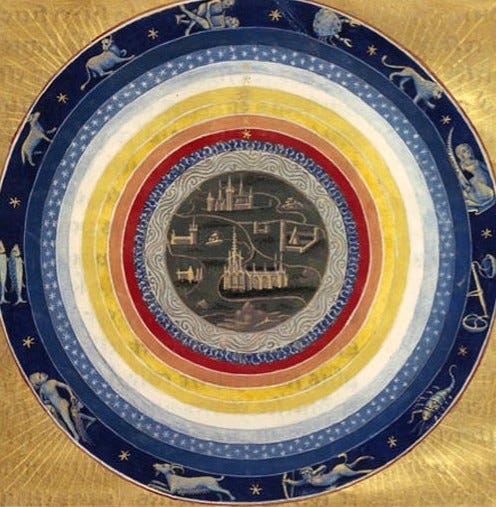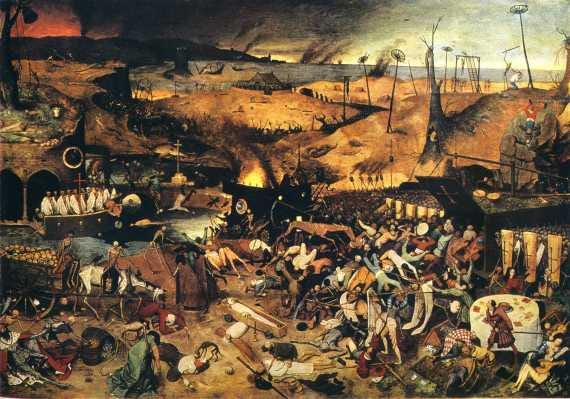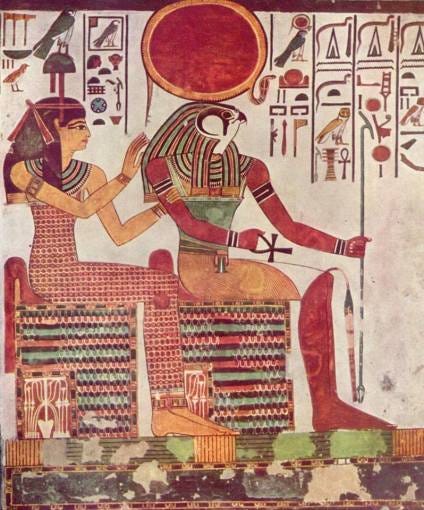There are many innate cognitive reasons and processes for people believing in and having particular conceptions of God or religious higher power. The belief in and description of god or higher power are byproducts, or extensions, of innate unconscious psychological tendencies humans use to function and survive as a species.
A human brain is a meaning-making machine. Humans constantly look for patterns, meaning, purpose, motives and cause-and-effect relationships wherever they go. These contribute to many religious and spiritual beliefs. Just as one tries to find motives, patterns and identifications in a room, photograph or abstract paintings, so do humans when contemplating the universe and unknowable.
The following are some of the cognitive processes that lead to religious beliefs.
.
The Search and Desire for Order
Humans tend to desire and strive to find order in situations, both in their daily lives and in ambiguous and chaotic information and situations. This is a natural part of identification, and an essential aspect of function and survival.
This extends to people’s perceptions about the unknowable universe and reality. Not only do many people want order and structure in the universe, they imagine it exists and artificially create it. This desire for order, structure and identity influences people in believing in God, a higher power and orderly universe. While not believing in God, many non-theists and scientists imagine that there are order and structure to the universe, even though it is impossible to know there is order. Even if there is order, it may be in a different form than humans can conceive of or sense.
In some religions, God brings order out of chaos, and religion is a fight for order in the face of chaos. The ancient Egyptians believed that the god Atum created earth and its order and principles out of chaos and darkness. It was the Egyptians’ duty to live moral and ethical lives to keep the chaos at bay.
It is a common religious belief that moral order comes from God or higher power, and some religious thus believe that an atheist cannot have morals.
.
The Innate Tendence to Perceive Meaning and Purpose Behind Things and Events
It is an innate tendency for humans to perceive and try to find meaning and purpose behind things. As with finding patterns and identification, this has been essential for human survival and function.
Knowing what is the purpose and meaning of a scene event, groups of people or non-human animals is part of social function and survival. If a group of people or dogs approach you, you want to know and do guess what is their purpose. If you hear a bang in the dead of night in your house, you want to know what is behind it and assume something is. Safety and self-preservation are about erring on assuming the worst, which is why many people get out of bed to check for intruder. Humans would not have survived as a species if they did not err on the side of safety.
In her paper Why Are Rocks Pointy? Children’s Preference for Teleological Explanations of the Natural World (source), psychology professor Deborah Keleman wrote that if you ask children why a group of rocks is pointy, many theorize that it is so animals don’t sit on them and break them. She said if you ask children why a river exists, they will often say so humans can fish in it. The children assign a meaning and purpose where they don’t exist, and ones that match their expectations, biases and human logic. Also note that they perceive the rivers to exist to serve humans.
Because of this bias, Kelemen says that children are able to come to the idea of a being that created the universe and earth with a purpose and meaning. This bias or tendency extends to many adults.
It takes training and education for one to overcome or be able to question these rote beliefs.
“Romanian Roma adults with little formal schooling (less than six years on average) were more than twice as likely to endorse purposeful answers than highly educated Roma adults (averaging approximately 12 years of schooling). They also more closely resembled American schoolchildren (first through fourth grades) than either highly educated Romanian adults or American adults. These results suggest that the tendency toward extending teleological reasoning from living to non-living natural things may recur across cultures, and that it is not merely outgrown but must be out-educated for it to go away.” — Justin L. Barrett Thrive Professor of Developmental Science, and Professor of Psychology at Fuller Graduate School of Psychology (reference )
.
Humans Perceive Minds Beyond Their Own
Humans are able to perceive others having minds. This is a part of function and survival of the species. Humans are social animals and need to guess the thoughts and intentions of human and non-human animals.
What is telling is that humans not only imagine minds in humans and other animals, but they imagine or project minds and thinking on inanimate objects. These include teddy bears, figures, artworks, dolls, toys, cars, movie projections. Humans easily accept cartoon characters that talk and think, even when the characters are cars, toasters and trees. Humans talk to paintings on their walls, and what the subject is thinking and doing.
Many either figuratively or literally imagine nature and the universe having minds, and this can lead to conceptions of God or higher power. Even non-religious scientists and philosophers talk about plants, the planet and the universe having consciousness, which, some could argue, is coming very close to believing in God.
.
Anthropomorphism
Humans have an innate tendency to perceive non-humans as thinking and feeling as humans do. Humans often incorrectly believe or imagine that a non-human animal thinks like a human and feels the same way about a happening as humans. Humans make non-human animal and non-animal cartoon characters that act like humans, see human faces in abstract information, and describe inanimate objects and nature in human terms: mother earth, father time. It should not surprise that humans can imagine the unseen universal reality as a being, that deities and Gods are depicted in human-like forms and having human-like thoughts, motives and ideas.
Similarly, humans often depict non-animal forms as having animal qualities. Howl of the wind, the hound of love. Many deities and gods are depicted in non-human animal forms.
Anthropomorphism is not always meant literally, but often as a symbolic translation. However, this all shows how humans see things and translate things in human terms, even nature, random information and the unknowable.
.
Humans Perceive Things in Human Emotional Terms
Emotions and aesthetics are an integral and constant part of human perception, judging and thinking. Humans innately and automatically make emotional judgments and perceptions. How new scenes are perceived, how to judge a stranger, how a foreign object is perceived, whether a new fact is true or false, are in part done on the intuitive, emotional, aesthetic level. Our descriptions of non-human things are steeped in human emotional and aesthetic terms and imagery: universal love, the angry sea, cruel fate, happy sun.
As people imagine the universe and unknowable in emotional terms, it is natural for people to see the transcendent reality not only in human terms but as human-like. All humans perceive and define the universe and ideas using their emotions and in human emotional terms. And a universe and reality that is believed to made up of human emotions is a step away from seeing it as a living being.
To humans, the meaning of life, of everything, is a matter of mood.
.
Humans Automatically Apply Narratives and Stories to Things
Just as humans interpret meaning, motive and identifications in ambiguous information, humans automatically interpret things– an object, a painting scene, a snapshot of a person– as part of an ongoing story and narrative. This is an expression of cause and effect, and human perception of time, meaning and purpose. Humans even apply narratives and stories to abstract information.
Humans apply such narrative and stories to the universe and the unknown, which means they interpret it in human ways. Religious scriptures are in the forms of stories and narratives. The Christian Bible has been referred to as “The Greatest Story Ever Told.”
.
Religious Symbols and Texts are Figurative and Translations
Depictions of gods and transcendent reality, religious stories and ceremonies are human translations of abstract ideas for understanding, teaching and communication. The learned religious know that they are just translations of ideas that are beyond human understanding.
Teaching must be done in languages the students understand. Jesus taught in parables, Buddha in en riddles. The Christian ‘Kingdom of God,’ doesn’t mean a physical building, but a state of enlightenment. Hindus use deities to represent transcendent reality, because a literal depiction would be beyond normal human comprehension and understanding. As the Hindu student becomes more and more learned the depictions of transcendent reality becomes more and more intricate and complex. Jesus himself, or at least as he is portrayed and symbolized, is a metaphor.
Some anti-theists and atheists make straw man arguments against theism, mocking their beliefs in deities and myths. However, they do not realize that the deities and stories are not taken literally by the learned religious. Learned Christians do not literally believe God is an old man with a white beard and robe sitting on a throne in heaven, and learned Hindus do not believe in thousands of Gods.
The Ancient Egyptian depictions of the gods were not intended as literal representations, as the Egyptians believed the gods’ true forms and natures were mysterious and beyond human comprehension. The depictions were in forms or symbols recognizable to humans and represented each god’s role in nature.
.
One’s Style of Thinking Influences One’s Beliefs
Those who come to conclusions emotionally and intuitively, or ‘from the gut,’ are more likely to believe in God or religious higher power. Those who have had their gut reactions proven correct, are more likely to trust the natural cognitive tendencies described in this chapter, and believe in magic, the paranormal and God.
Those who think logically and in the past had their intuition proven wrong are less likely to believe in God or a religious higher power. They have learned to question, or double check, their normal cognitive biases and innate tendencies. They think of other possibilities.
“It is the standard skeptical narrative that people are biased in numerous ways. The “default mode” of human behavior is to drift along with the currents of our cognitive biases, unless we have critical thinking skills as a rudder or paddle (choose your nautical metaphor). Metacognition – thinking about thinking – is the only way for our higher cognitive function (evidence, analysis, logic) to take control of our beliefs from our baser instincts”– Steve Novella MD, Assistant Professor of Neurology, Yale University (reference)
.
More Conscious Reasons
Humans often choose to believe in a god and higher powers for conscious and calculated reasons. These include if they so greatly dislike chaos that they choose an artificial answer, they want purpose in their life, they fear death, like the idea of universal justice, want a way to deal with loss or suffering. Some do it because it makes them feel better.
Many are theists in order to fit in with a theistic culture or community. Many religious beliefs are an integral part of culture. Major reasons people belong to a church for the social aspects and community. Believing in a religion and following its practices is as natural as being a part of the community and culture.
.
Social Order
Shared beliefs, purpose and meaning are important for any social group, and many societies and groups have used God or higher power to keep societies together and functioning. Games require rules, often arbitrary ones. This is a standard reason for the belief in God, even today. Of course many leaders have called themselves deities or gods or said they had a special connection to higher power.
“Dogmatic religion stems from a psychological need for group identity and belonging, together with a need for certainty and meaning. There is a strong impulse in human beings to define ourselves, whether it’s as a Christian, a Muslim, a socialist, an American, a Republican, or as a fan of a sports club. This urge is closely connected to the impulse to be part of a group, to feel that you belong, and share the same beliefs and principles as others. And these impulses work together with the need for certainty—the feeling that you “know,” that you possess the truth, that you are right and others are wrong.”– Leeds Beckett University psychology lecturer Steve Taylor (Reference )
In the beginning and end, humans can only perceive, think about and conceptualize things in human ways– their biases, logic, biology, intuition senses and logic. Thus, the perception of the universe and abstract is seen and described in human ways and with human qualities and concepts. It should be of no surprise that many think of and describe the universe in human-like imagery and with human-like stories and motives. The non-religious do as well, if not invoking a deity.
.
These Processes Neither Prove Nor Disprove the Exitance of God
Some will say these innate psychological processes prove that God does not exist and is merely the product of the human mind. This is not true. They certainly are evidence that religious and other conceptions are in part human creations, but they are not proof against or for the existence of God or higher power.








